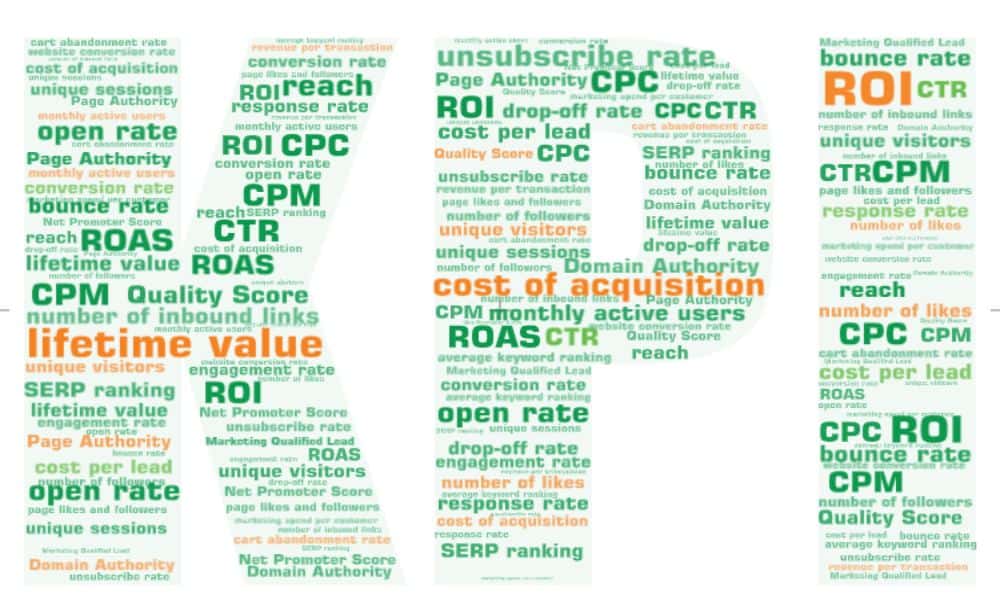What Marketing KPIs do you track?
KPIs – key performance indicators – are dear to my heart. Tracking is essential to find out what works and to find out whether changes make things better or worse.
KPIs are also rampant across all aspects of business, including marketing. Marketers track everything from click-through rate to open rate to engagement, number of shares, unique visitors, conversions, unsub rate… …they might all be performance indicators, but surely they can’t all be key ones.
For KPIs for specific kinds of marketing, check out this more detailed post.
So if you’re short of time or just starting out, what are the key performance indicators you need to focus on?
My vote is firmly with just two:
- Cost of Acquisition (COA)
- Lifetime Value (LTV)
What’s so great about these two measures? Three things:
- They are directly related to money. Which is something just about every business owner or manager I know is interested in.
- Taken together, they are directly related to profitability. At the most basic level, if it costs you more to acquire a customer than you are going to make from that customer, you are going to go broke.
- You can apply these measures to whatever kind of marketing you are doing. You can calculate them for the whole of your business, or for a specific kind of customer, or for customers from a specific channel, or from a specific campaign. You can compare. You can see not only which of your marketing options work, but which of them work best.
Marketing is (or should be) focused on one or both of two goals:
- acquire new customers
Even if marketing is generating leads and then handing them over to sales, you need a focus on customers as well as leads. Leads don’t pay bills. You may choose to track leads AND customers – that’s often the best option, but don’t forget the end goal of generating revenue.
Cost of acquisition tracks performance against this goal.
(You probably also want to look at total number of new customers, but that’s a different topic.) - make more money from existing customers
We all know it’s generally cheaper to look after an existing customer than to find a new one. You can upsell, cross-sell, repeat sell or tie into a contract. You are building on an existing relationship to give more value to your customer and generate more revenue for yourself.
Lifetime value tracks performance against this goal.
So why do all those other KPIs exist?
As I said before, I’m data-driven and I LOVE tracking results, so I’m certainly not proposing you abandon all the other KPIs. However, I would suggest you look at them in the context of how they support lowering COA and increasing LTV.
They are the tools you use to dig deeper once you have identified a specific part of your marketing you want to focus on.
For example, you’re running new customer acquisition campaigns via Google Adwords, ads on a relevant site, trade show attendance and direct mail to an external database you have rented or bought. You know the direct costs of each campaign. You track how many customers you get from each campaign. So you can easily calculate the COA for each campaign and for your business overall.
- The ads on the relevant site had by far the lowest COA, but only delivered 10% of all your new customers. You’re already visible to all visitors, so it’s hard to expand this campaign. Google Adwords, on the other hand, generated 60% of new customers, but the COA was very high. So you decide to go on working with Google Adwords because you need the volume, but try to make it perform better.
- You use more granular KPIs to look at where your Adwords campaign can be improved:
-
What’s your click-through rate? (the percentage of people who see your ads and actually click on them) Use this to work out which keywords and ads perform best at attracting visitors to your site. Remove or improve poor performers.
-
What’s your bounce rate? (the percentage of people who click on your ads and then leave your site without doing anything else at all) You pay for these visits but get no value from them. A high bounce rate is a sign that something’s wrong. Pages with a decent amount of traffic and a high bounce rate probably need to be redesigned to capture visitor interest. Alternatively, you may need to split into several pages for visitors with different needs (ie who entered different keywords)
- You make the changes and carry on with Adwords. In a week or two you can look at the metrics again. Now you can see, for each change you made, whether the results got better or worse.
- You can do the same kind of thing with the direct mail campaign. Send two different offers or promotional pieces and see which one does better.
The other great thing about metrics like response rate, CTR, bounce rate and so forth is that you can get some kind of comparison as to how you’re doing compared to other companies – which may give you visibility of what to work on and improve. Not that many companies will share their cost of acquisition with the general public, but there are benchmarks and guideline ranges for all sorts of other metrics.
So by all means use a variety of KPIs, but be sure you know why you are using them. And never, ever forget the two most important KPIs of all – cost of acquisition and lifetime value!
***
If you’d like to talk through the best KPIs for your business, or if you’re having trouble working out your LTV, contact NoBull and we can get together to sort it out.







